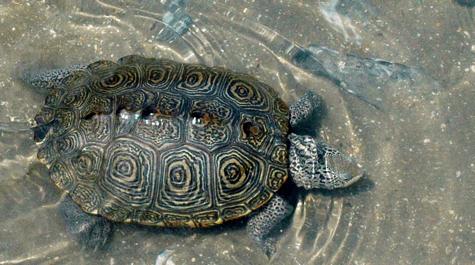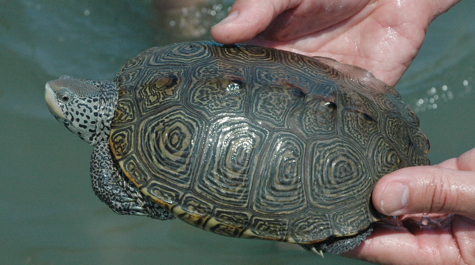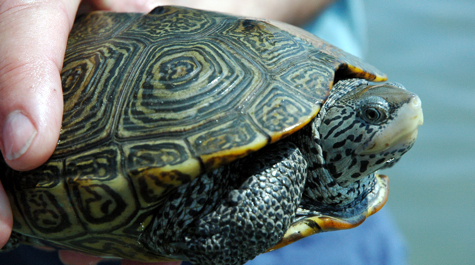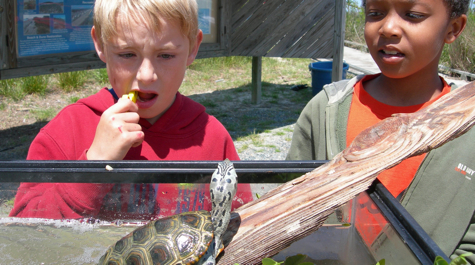Diamondback Terrapins
Diamondback terrapins (Malaclemys terrapin) are the only turtles in the U.S. that live exclusively in brackish saltwater marshes, coastal bays, and lagoons. They range from Cape Cod, Massachusetts to Corpus Christi, Texas, including Chesapeake Bay. Terrapins mainly stay in the water though they can be spotted basking along marsh banks. They are named for the concentric markings and grooves on their shells. They are not sea turtles, but like sea turtles their populations are in trouble. Threats include drowning in crab pots, habitat loss, nest predation, and boat strikes.
Size
Male and female terrapins are different sizes. Adult females can reach nearly 12 inches in length; nearly twice the 6-inch shell length of a typical adult male.
Age & Sexual Maturity
Diamondback terrapins can live upwards of 40 years. Males reach sexual maturity in 2–3 years, females reach sexual maturity at 6–7 years.
Nesting
During the summer, adult females look for sandy beach areas or coastal sand dunes to lay eggs. A single female can lay up to 3 clutches of eggs per nesting season. Similar to other turtles, terrapins have a low egg-to-hatchling survival rate as nests and hatchlings often fall victim to predation from raccoons, crows, rats, wading birds, and large fish.
Habitat
Brackish coastal wetlands of the eastern and southern United States, from Cape Cod, Massachusetts to Corpus Christi, Texas.
Diet
Diamondback terrapins feed on a variety of marsh crabs, snails, mussels, clams, and barnacles depending on where the terrapins live along their range. In Virginia, they feed primarily on barnacles, blue crabs and marsh crabs, snails, and mussels. Terrapins can crush mollusk shells due to the bony plates of their upper and lower jaw.
Status
Diamondback terrapins were once plentiful in Chesapeake Bay, but their populations were decimated from the late 1880s to the early 1900s from commercial harvest that supported the demand for turtle soup. The commercial demand for terrapins ended by the 1930s as a result of low terrapin populations and Prohibition, as sherry was another of the soup's key ingredients.
In Virginia, it is now illegal to collect diamondback terrapins for commercial or personal use. The Virginia Department of Game and Inland Fisheries considers the Commonwealth's diamondback terrapin population as "Near Threatened."
Diamondback terrapins face numerous threats, including habitat loss, boat strikes, and nest predation by raccoons and other animals. But their greatest threat is drowning in crab pots. Terrapins are attracted by the same bait used to lure blue crabs to crab pots. Once the turtles get inside, most can't escape, and because they are air-breathing animals, they eventually drown. The problem is most pressing among the pots set by recreational crabbers, which typically sit in shallow waters along creeks and marshes. This is prime territory for males and juvenile female terrapins. Because of their smaller size, these terrapins are particularly vulnerable to capture and drowning. Installation of bycatch reduction devices has been shown to be an effective way to reduce this threat.




